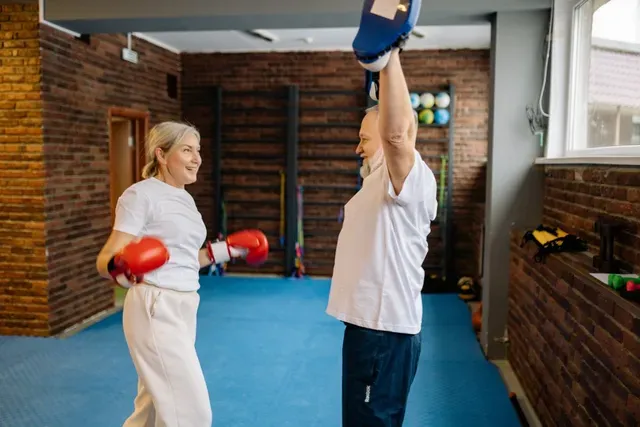Parkinson’s Disease and Rock Steady Boxing
Author: James Mclean, SPT
Background:
Parkinson’s Disease (PD) is a condition treated by Physical Therapists at Back to You Osteopractic Physical Therapy & Rehabilitation in Royal Oak, Grosse Pointe Woods, and Canton, Michigan as well as Port St. Lucie, Florida. It is a chronic and progressive movement disorder which affects neurons in the substantia nigra which is a part of the brain. Dopamine (a neurotransmitter) in the brain is important for controlling movement and coordination. In PD, the amount of dopamine decreases which in turn effects movement and coordination. The most common motor symptoms include resting tremor, bradykinesia, rigidity, and postural instability. Some other symptoms include “pill rolling” and freezing gait.
Stages of Parkinson’s Disease:


What is Rock Steady Boxing (RSB)?:
· RSB is a non-contact boxing program that is explicitly for individuals with Parkinson’s Disease. The 90-minute exercise classes focus on agility, balance, and speed training. Improvement in balance, gait velocity, and quality of life.
Where is the Evidence?
Article #1:
· Title: Boxing Exercises as Therapy for Parkinson’s Disease
· Major Findings: There were 47 participants in this study who completed RSB. 100% of the participants who answered the survey agreed or strongly agreed that they enjoyed the class. Most of the participants noted improvements in PD symptoms like body stiffness, mood, fatigue, gait (walking) & balance. There were also increases in standardized outcome measures that correlate to independence and risk of falls.
Article #2:
· Title: Effects of Rock Steady Boxing
· Major Findings: This study of 26 participants conducted a survey of people who completed RSB. 50% selected agree to having increased balance. 94% selected strongly agree on increased coordination. 100% strongly agree and agree that the program improved independence at home. 71% selected agree or strongly agree on decreased number of falls.
Article #3:
· Title: Effects of Rock Steady Boxing on Activities of Daily Living and Motor symptoms of Parkinson’s Disease
· Major Findings: This study was of 12 participants who were assessed after 12-14 weeks of RSB. This study noted improvements in PD specific subjective outcome measures and standardized outcome measures like the Timed-Up and Go test (TUG), 10-meter walk test, and the Berg Balance Scale. There was an average decrease in TUG time by 2.4 seconds. The 10-meter walk decreased by 0.5 seconds. Lastly, the berg increased by 0.8 points.
References:
· Danielle Larson, Danny Bega, Eric Johnson, & Laura Slowey. (2018). Effects of Rock Steady Boxing on Activities of Daily Living and Motor Symptoms of Parkinson’s Disease (P5.075). Neurology, 90(15 Supplement), P5.075. · Boxing Exercises as Therapy for Parkinson Disease. (n.d.). Retrieved July 21, 2023, from https://oce-ovid-com.proxy.lib.wayne.edu/article/00013614-202007000-00005/HTML
· Hall, H., Walker, J., & Smith-Goodwin, E. (2022). Effects of Rock Steady Boxing on Parkinsons Patients. Journal of Sports Medicine and Allied Health Sciences: Official Journal of the Ohio Athletic Trainers’ Association, 8(1). https://doi.org/10.25035/jsmahs.08.01.15

